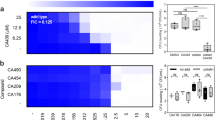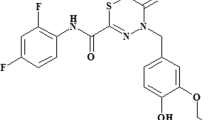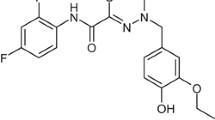Abstract
Emerging drug resistance in Salmonella coupled with the recent poor success rate of antibiotic discovery programs of the pharmaceutical industry is a cause for significant concern. It has forced the scientific community to look for alternative new classes of antimicrobial compounds. In this context, combinations of antimicrobial peptides (AMPs) and conventional antibiotics have gained interest owing to their versatile applications. The present study was therefore planned to evaluate the synergistic effects, if any, of cryptdin-2, a mouse Paneth cell alpha-defensin, in combination with four different antibiotics i.e. ciprofloxacin, ceftriaxone, cefotaxime and chloramphenicol, which are conventionally used against Salmonella. Minimum bactericidal concentrations of the selected antimicrobial agents were determined by micro and macro broth dilution assays. In-vitro synergy between the agents was evaluated by fractional bactericidal concentration index (checkerboard test) and time-kill assay. Cryptdin-2-ciprofloxacin, cryptdin-2-ceftriaxone and cryptdin-2-cefotaxime combinations were found synergistic as evident by in vitro assays. This synergism provides an additional therapeutic choice by allowing the use of conventional antibiotics in conjunction with AMPs against MDR Salmonella.


Similar content being viewed by others
References
Haraga A, Ohlson MB, Miller SI (2008) Salmonellae interplay with host cells. Nat Rev Microbiol 6:53–66
Singh AP, Preet S, Rishi P (2011) Augmentation of antimicrobial activity of conventional antibiotics by cell free extract of L. plantarum. J Antibiot 64:795–798
Chalon MC, Acuña L, Morero RD, Minahk CJ, Bellomio A (2012) Membrane-active bacteriocins to control Salmonella in foods: are they the definite hurdle? Food Res Int 45:735–744
Wiradharma N, Khoe U, Hauser CA, Seow SV, Yang YY, Zhang S (2011) Synthetic cationic amphiphilic α-helical peptides as antimicrobial agents. Biomaterials 32:2204–2212
Marr AK, Gooderham WJ, Hancock RE (2006) Antibacterial peptides for therapeutic use: obstacles and realistic outlook. Curr Opin Pharmacol 6:468–472
Mastroianni JR, Ouellette AJ (2009) α-Defensins in enteric innate immunity: functional Paneth cell α-defensins in mouse colonic lumen. J Biol Chem 284:27848–27856
Ayabe T, Satchell DP, Wilson CL, Parks WC, Selsted ME, Ouellette AJ (2000) Secretion of microbicidal α-defensins by intestinal Paneth cells in response to bacteria. Nat Immunol 1:113–118
Hancock REW, Sahl HG (2006) Antimicrobial and host-defense peptides as new anti-infective therapeutic strategies. Nat Biotechnol 24:1551–1557
Masuda K, Sakai N, Nakamura K, Yoshioka S, Ayabe T (2010) Bactericidal activity of mouse α-defensin cryptdin-4 predominantly affects noncommensal bacteria. J Innate Immun 3:315–326
Preet S, Rishi P (2010) Antimicrobial activity of Paneth-cell derived cryptdin-2 against selected pathogens. Am J Biomed Sci 2:13–22
Foureau DM, Mielcarz DW, Menard LC et al (2010) TLR9-dependent induction of intestinal alpha-defensins by Toxoplasma gondii. J Immunol 184:7022–7029
Tanabe H, Ouellette AJ, Cocco MJ, Robinson WE (2004) Differential effects on human immunodeficiency virus type 1 replication by α-defensins with comparable bactericidal activities. J Virol 78:11622–11631
Cassone M, Otvos L Jr (2010) Synergy among antibacterial peptides and between peptides and small-molecule antibiotics. Expert Rev Anti Infect Ther 8:703–716
Giacometti A, Cirioni O, Barchiesi F, Fortuna M, Scalise G (1999) In-vitro activity of cationic peptides alone and in combination with clinically used antimicrobial agents against Pseudomonas aeruginosa. J Antimicrob Chemother 44:641–645
Yenugu S, Narmadha G (2010) The human male reproductive tract antimicrobial peptides of the HE2 family exhibit potent synergy with standard antibiotics. J Pept Sci 16:337–341
Preet S, Verma I, Rishi P (2010) Cryptdin-2: a novel therapeutic agent for experimental Salmonella typhimurium infection. J Antimicrob Chemother 65:991–994
Rishi P, Preet S, Bharrhan S, Verma I (2011) In-vitro and in vivo synergistic effects of cryptdin 2 and ampicillin against Salmonella. Antimicrob Agents Chemother 55:4176–4182
Rishi P, Preet S, Kaur P (2011) Effect of L. plantarum cell-free extract and co-trimoxazole against Salmonella typhimurium: a possible adjunct therapy. Ann Clin Microbiol Antimicrob 10:9
Birosova L, Mikulasova M (2009) Development of triclosan and antibiotic resistance in Salmonella enterica serovar typhimurium. J Med Microbiol 58:436–441
Mandal S, Mandal MD, Pal NK (2004) Synergism of ciprofloxacin and trimethoprim against Salmonella enterica serovar typhi isolates showing reduced susceptibility to ciprofloxacin. Chemotherapy 50:152–154
Aarestrup FM, Wiuff C, Molbak K, Threlfall EJ (2003) Is it time to change fluoroquinolone breakpoints for Salmonella spp.? Antimicrob Agents Chemother 47:827–829
Fey PD, Safranek TJ, Rupp ME et al (2000) Ceftriaxone-resistant Salmonella infection acquired by a child from cattle. N Engl J Med 342:1242–1249
Endt K, Maier L, Käppeli R, Barthel M, Misselwitz B, Kremer M, Hardt WD (2012) Peroral ciprofloxacin therapy impairs the generation of a protective immune response in a mouse model for Salmonella enterica serovar Typhimurium diarrhea, while parenteral ceftriaxone therapy does not. Antimicrob Agents Chemother 56:2295–2304
Lencer WI, Cheung G, Strohmeier GR, Currie MG, Ouellette AJ, Selsted ME, Madara JL (1997) Induction of epithelial chloride secretion by channel-forming cryptdins-2 and 3. Proc Natl Acad Sci USA 94:8585–8589
Campos MA, Morey P, Bengoechea JA (2006) Quinolones sensitize Gram-negative bacteria to antimicrobial peptides. Antimicrob Agents Chemother 50:2361–2367
Darveau RP, Cunningham MD, Seachord CL, Cassiano-Clough L, Cosand WL, Blake J, Watkins CS (1991) Beta-lactam antibiotics potentiate magainin 2 antimicrobial activity in vitro and in vivo. Antimicrob Agents Chemother 35:1153–1159
Ulvatne H, Karoliussen S, Stiberg T, Rekdal O, Svendsen JS (2001) Short antibacterial peptides and erythromycin act synergically against Escherichia coli. J Antimicrob Chemother 48:203–208
Acknowledgments
The authors express their gratitude to Mr. Navtej Singh at Central Instrumentation Laboratory, Panjab University, Chandigarh, India, for providing assistance in photographic analysis of the samples. The authors also wish to acknowledge the Council of Scientific and Industrial Research, New Delhi, for providing financial assistance to carry out this work.
Author information
Authors and Affiliations
Corresponding author
Rights and permissions
About this article
Cite this article
Singh, A.P., Prabha, V. & Rishi, P. Efficacy of Cryptdin-2 as an Adjunct to Antibiotics from Various Generations Against Salmonella . Indian J Microbiol 54, 323–328 (2014). https://doi.org/10.1007/s12088-014-0463-y
Received:
Accepted:
Published:
Issue Date:
DOI: https://doi.org/10.1007/s12088-014-0463-y




